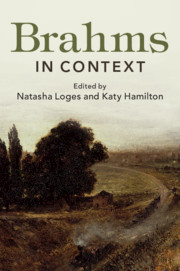Book contents
- Brahms in Context
- Brahms in Context
- Copyright page
- Dedication
- Contents
- Illustrations
- Music Examples
- Notes on Contributors
- Preface
- Abbreviations
- Part I Personality, People and Places
- Part II Identities, Environments and Influences
- Part III Performance and Publishing
- Part IV Society and Culture
- Part V Reception and Legacy
- Chapter 31 Germany
- Chapter 32 England
- Chapter 33 Analysis
- Chapter 34 The Era of National Socialism
- Chapter 35 Editing Brahms
- Chapter 36 Recordings
- Chapter 37 Historical Performance
- Chapter 38 Inspiration
- Chapter 39 Mythmaking
- Further Reading
- Index
- References
Chapter 37 - Historical Performance
from Part V - Reception and Legacy
Published online by Cambridge University Press: 15 May 2019
- Brahms in Context
- Brahms in Context
- Copyright page
- Dedication
- Contents
- Illustrations
- Music Examples
- Notes on Contributors
- Preface
- Abbreviations
- Part I Personality, People and Places
- Part II Identities, Environments and Influences
- Part III Performance and Publishing
- Part IV Society and Culture
- Part V Reception and Legacy
- Chapter 31 Germany
- Chapter 32 England
- Chapter 33 Analysis
- Chapter 34 The Era of National Socialism
- Chapter 35 Editing Brahms
- Chapter 36 Recordings
- Chapter 37 Historical Performance
- Chapter 38 Inspiration
- Chapter 39 Mythmaking
- Further Reading
- Index
- References
Summary
Brahms holds a special place among the major instrumental composers in that not only does his life straddle major changes in instrumental design and performance practices, but that recollections and sound recordings exist by younger contemporaries to illustrate these. Indeed, there is sufficient evidence to encourage many different perspectives, and the field has become one of lively debate. In this, there are two extremes of interpretation: first the historically driven view that stresses fundamental differences of instruments and performing styles; second, a traditional view of continuity from the past that accepts modern adaptation and expression of these factors. Although the latter is not essentially concerned with historical issues, it cannot be ignored because it represents a permanent counterweight to the historical approach, which remains problematic for many in its implications for modern performance style and social function [see Ch. 23 ‘Instruments’].
- Type
- Chapter
- Information
- Brahms in Context , pp. 367 - 375Publisher: Cambridge University PressPrint publication year: 2019

